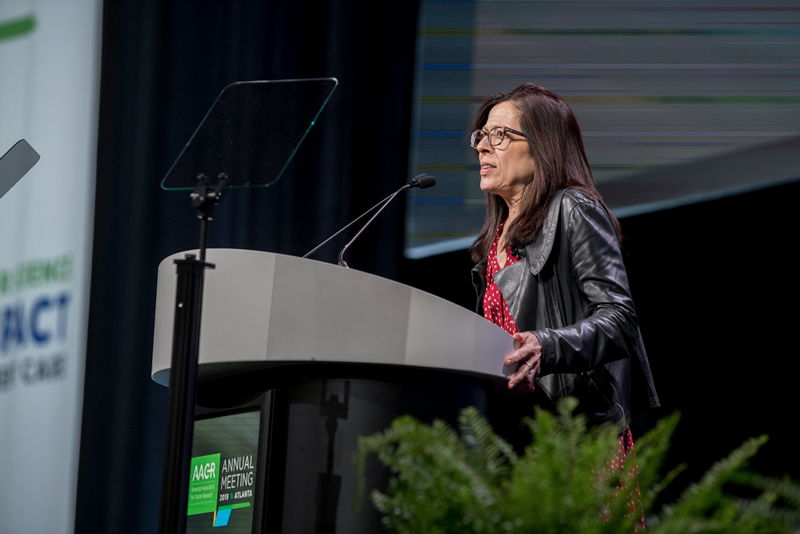This year’s annual meeting of the American Association for Cancer Research (AACR19), which ended this week, was noticeably different from the association’s previous meetings. Typically, data from basic research and preclinical studies dominates the conference, and, to be sure, there was plenty of that to go around. This year, however, “this meeting had more clinical trials presented than any other AACR meeting in the past,” according to the association’s outgoing president, Elizabeth Jaffee, M.D., in an address given during the closing session.

Dr. Elizabeth Jaffee makes closing remarks.
Perhaps more significant than the sheer number of trials presented, however, was the diversity of novel strategies that these trials employed. They explored new ways to prevent, detect, and treat cancer, including cancers that have historically been difficult to treat. Above all, the trials brought strong basic science into the clinical setting. Instead of looking only at whether patients respond to treatment, many of the trials sought to understand—at a mechanistic level—why patients were responding or not responding. In this way, said Jaffee, AACR19 highlighted “all the great science that our community is doing.”
To help recap the incredible scope of advances, Jaffee introduced three other speakers, who together took on the challenge of “adequately representing the breadth of…the basic research that’s so important and drives forward the clinical translation that ultimately makes a difference in the lives of our patients every day.”
Cancer Detection and Prevention
First, Marcia R. Cruz-Correa, M.D., Ph.D., of the University of Puerto Rico, began by discussing how we might be able to detect cancer earlier or even prevent it altogether.
Many factors can give rise to cancer. “One factor depends on us, on our lifestyle,” said Cruz-Correa, before noting that roughly half of all cancer deaths in the Western world result from preventable factors.
“What we know thus far is that physical activity as well as weight loss help decrease the risk of twelve cancers associated with excess body fat,” according to Cruz-Correa, who then pointed to a trial that sought to determine whether or not regular physical activity mitigated the association of high body mass index (BMI) with increased cancer risk.
By following more than 100,000 men and women since the early 1990s, they determined that, “for both men and women, despite the fact that the BMI was not reduced, having an active lifestyle decreased the risk of developing cancer associated with excess body fat.”

Dr. Marcia Cruz-Cortez discusses cancer detection and prevention.
Next, Cruz-Correa turned to the impact of our diets, noting that the World Health Organization classified processed red meats as a class 1 carcinogen, “the same class where we have asbestos and tobacco.”
In one study, “individuals that reported consumption of red meats in the upper quartile had two times more likely the risk of having high-risk polyps,” whereas another study demonstrated the potential benefits of substituting plant-based proteins for animal products by comparing patients whose protein intake was either 70%, 50%, or 30% animal product-based.
“Very interestingly, and in such a short period of time—we’re talking only three months—they were able to show that those individuals with the higher percentage of plant-based proteins had the lowest percentage of compounds…associated with risk of inflammation and, eventually, cancer.”
Lastly, Cruz-Correa turned to early detection. “If you’re able to detect cancer at an early stage, we can provide the best [chance of] survival for the patient,” she said. In one ovarian cancer trial, more than 100 biomarkers were investigated for their diagnostic capabilities, and it was found that screening for the combination of several biomarkers was able to detect nearly 80% of all women in the study with early-stage ovarian cancer.
“That is an improvement from our current methods,” Cruz-Correa noted. “There are still more data to be collected, but we’re hoping that these and other biomarkers will allow us to screen and detect cancer earlier.”
Promising new diagnostic techniques were also identified in lung cancer, which Cruz-Correa reminded the audience is still among the top three causes of mortality worldwide. Fortunately, new data presented at AACR19 showed that using the combination of circulating tumor DNA, in association with a specific model for imaging, was able to correctly identify the lesions as being benign or not 100% of the time.
This demonstrates, according to Cruz-Correa, “how combining methods that we have right now with new and evolving methodologies will help increase our diagnostic accuracy and will help us hopefully diagnose early and prevent death. Blood-based screening is on the rise and continues to increase, and hopefully it will allow us to have less invasive, more effective tests for early detection of cancer.”
Translational Research
Next, John D. Carpten, Ph.D., of the University of Southern California, who spoke about the basic science and translational research highlights at AACR19 as well as the challenges that must still be addressed. Single cell sequencing, which allows each individual cancer or immune cell to be analyzed, offers incredible precision and can provide a wealth of information about the composition of tumors and the immune system. This approach, however, can also strip the situation of important spatial context.
To that end, Carpten stressed that we’re starting to see the development of new technologies that might help us overcome this limitation and “hopefully allow us to develop 3D heat maps of tumors and really understand spatial context and the cellular interplay that’s occurring with the tumor.”

Dr. John Carpten discusses technology and drug resistance.
Another area Carpten focused on was drug resistance, noting that, “there’s a need to continue clarifying clinical and molecular definitions, and [a need for] improvements in methods for detection of resistance.” In the context of immunotherapy, several types of resistance can occur, and it will be “important to distinguish between the intrinsic versus the extrinsic, or acquired, causes of resistance” in order to ensure that the appropriate therapies are used to treat individual patients. These different types of resistance—and therapeutic strategies to counter them—were discussed in depth by UCLA’s Antoni Ribas, M.D., Ph.D., on Day 5 of the conference.
“Immuno-oncology, of course, is a major theme at AACR,” said Carpten, who acknowledged “the amazing work in cell-based therapies and CAR T cell therapies…in pediatric cancer that are showing incredible promise.” However, “immune exhaustion in cancer therapy is another major area as we believe that it might be significantly involved in resistance to immunotherapy,” he added.
Advances in CAR T cell immunotherapies as well as efforts to better understand exhaustion were highlighted extensively during Day 3 of AACR19.
Biomarkers
Prior to the closing session on AACR19’s final day, Suzanne Topalian, M.D., of Johns Hopkins University, examined the current state of predictive biomarkers with respect to immunotherapies targeting the PD-1/PD-L1 checkpoint pathway, bringing together much of what was discussed throughout Day 4 of the conference. The U.S. Food and Drug Administration has already issued checkpoint immunotherapy approvals incorporating two biomarkers: PD-L1 expression and high microsatellite instability (MSI-hi). Topalian noted that both tumor cells and macrophages (a type of immune cell) can express PD-L1, and that the density of interactions between these PD-L1-expressing cells and PD-1-expressing T cells appears to be important, as it correlates with patient responses to therapies targeting this immune checkpoint.
Topalian also highlighted the importance of trials treating patients with immunotherapy prior to surgery (known as neoajudvant therapy). In addition to potentially priming a systemic immune response, this approach can reduce tumor volume prior to surgery and provide crucial samples that enable doctors to interrogate how immunotherapy affects the activity of both cancer cells and immune cells within tumors. Thus far, these studies have also begun to reveal pathological responses prior to surgery as a biomarker of overall patient survival. Furthermore, they’ve shown that a tumor’s mutational burden might be able to serve as a predictor of pathological response and, in turn, overall survival.
According to Topalian, in order to further improve our ability to discover and validate new biomarkers, the development of multiplex biomarker panels—that account for T cells as well as B cells, dendritic cells, and other immune components—will be crucial. Ultimately, by teasing apart the contributions of the different cells and molecular pathways, the mechanisms that enable response or resistance can be identified. Then, “a deeper understanding of the mechanisms of action for immune checkpoint pathways [can be used to] guide the design of more effective cancer immunotherapies.”
Clinical Trials
Finally, Patricia LoRusso, D.O., of Yale University, wrapped up the closing session with a recap of “the explosion of clinical research, especially in immuno-oncology clinical research, that we saw here at AACR 2019.”
She first pointed to several trials employing novel designs, including the iSPY-2 trial that is “using novel drugs in a neoadjuvant setting, which is a significant advantage in terms of the potential…to be able to increase our assessment of these drugs.”
The PRINCE pancreatic cancer trial, which is utilizing a novel immunotherapy-chemotherapy combination as a first-line treatment for patients with metastatic pancreatic cancer, was also showcased by LoRusso due to the significant responses achieved with this approach. Speaking about the graph that visualized the extent to which 20 of the 24 patients’ tumors had shrunk, she explained that “this type of plot is very rare.”

Dr. Patricia LoRusso discusses encouraging clinical trial data.
Biomarker analysis from the MYSTIC trial, which was unveiled on Day 4, showed that, “those patients whose tumors had tumor mutational burdens of greater than 20 [mutations per million base pairs] demonstrated the best survival.” In these patients, combination checkpoint immunotherapy was associated with a two-fold greater benefit versus chemotherapy. Another interesting trial involved patients that were resistant to PD-1 immunotherapy, who then saw improved responses to re-treatment after receiving fecal microbiota transplants (FMT) from patients who had durable responses to PD-1 immunotherapy. Lastly, she highlighted the Keynote-189 trial, in which a subset of lung cancer patients with liver or brain metastases were treated with the combination of PD-1 immunotherapy and chemotherapy, calling it “a home run in terms of the responses obtained in these patients.”
In closing, LoRusso went over her “wish list” for next year’s AACR annual meeting, which included: more translational bench-to-bedside-to-bench research that explores biomarkers that might potentially be useful in the clinic; more of the promising phase I trials being turned into larger studies to more accurately gauge their potential; applying novel treatment strategies in the first-line and even pre-surgical setting; more innovative delivery systems to allow for lower doses of treatments to be delivered to where they are most needed; and “studies where we’re overcoming financial and social barriers to enhance upfront and earlier therapeutics for under-represented populations.”
Most importantly, LoRusso stressed the importance of AACR and its partners continuing “in their mission to put patients first and foremost in this battle.”